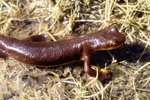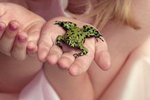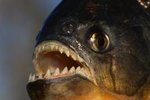
Green darner dragonflies (Anax junius) are big insects that are prevalent all over North America, including the Caribbean region, and Russia. These family Aeshnidae dragonflies generally live in areas surrounding water -- think streams, marshes, estuaries, lakes, bays and ponds. Green darner dragonflies tend to gravitate to especially still and calm streams. They are often called common green darners.
Appearance
These sizable and conspicuous dragonflies generally grow to lengths of between 2.25 and 3.5 inches. Males are bigger than females. Both their thoraxes and heads are green. The males have narrow blue stomach regions, while the females' are brown and yellow. Green darner dragonflies' wings are clear, although they become yellowish close to the edges. Other noteworthy features of the insects are their big eyes, prickly limbs and sturdy jaws.
Lifespan
Green darner dragonflies are not long-lived creatures in any sense. They often survive for a little over a year, according to the website for the Illinois State Museum. This typical life expectancy takes into consideration various periods of their lives, including their egg, nymph and fully mature days. The larval period is the longest stage for green darner dragonflies.
Time as an Adult
The lifespan for adults of this rapid-flying species is extremely brief, usually ranging from four to seven weeks. Green darners typically have so little time as adults that most of it's spent engaging in reproductive activities. Breeding generally takes place in the summertime, in both July and August.
Diets
At all ages, members of this species are carnivores, although green darner dragonflies eat slightly different diets depending on the specific point in their lifespans. As larvae, they typically go for water bugs, such as the larvae of flies, mayflies and mosquitoes. They also dine readily on crustaceans such as shrimp, as well as tadpoles and tiny fish. During a green darner's short life as an adult, it feeds on insects, insects and more insects, from termites to mosquitoes and moths.
References
- Michigan Department of Natural Resources: Green Darner Dragonfly
- University of Michigan Animal Diversity Web: Anax junius
- Montana Field Guide: Common Green Darner
- Idaho Museum of Natural History: Common Green Darner
- Texas Parks and Wildlife: Common Green Darner
- Illinois State Museum: The Dragonfly - Friend or Foe?
- IUCN Red List of Threatened Species: Anax junius
Photo Credits
-
Jupiterimages/Photos.com/Getty Images




